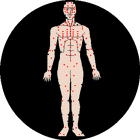
Dr Michael Kelly Ancient Theories Osteopathic Medicine Home Dim Mak Points Books
Testimonials Links Medical Practice Dim Mak Online Dim Mak Injury Study Dim Mak /Pressure Points
Dimmak.net LLC

Rare information on combat sports including martial arts, boxing, and wrestling.
Fight Medicine
Dim Mak/Pressure Points
Fight Injuries